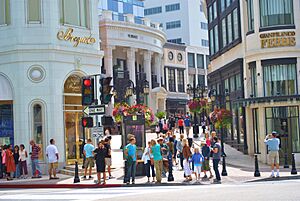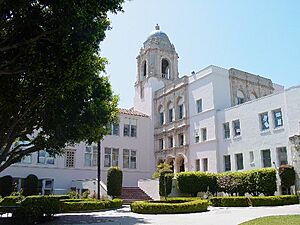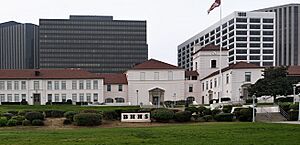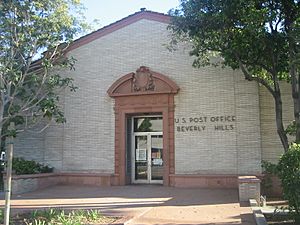Beverly Hills, California facts for kids
Quick facts for kids
Beverly Hills, California
|
|||||
|---|---|---|---|---|---|
|
Beverly Hills City Hall
Rodeo Drive
Beverly Cañon Gardens
|
|||||
|
|||||
| Nicknames:
"Garden Spot of the World," "B.H.," "Bev Hills," "90210,"
|
|||||

Location within Los Angeles County, California.
|
|||||
| Country | United States | ||||
| State | California | ||||
| County | Los Angeles | ||||
| Incorporated | January 28, 1914 | ||||
| Named for | Beverly Farms in Beverly, Massachusetts | ||||
| Government | |||||
| • Type | Council–manager | ||||
| Area | |||||
| • Total | 5.71 sq mi (14.79 km2) | ||||
| • Land | 5.71 sq mi (14.78 km2) | ||||
| • Water | 0.00 sq mi (0.00 km2) 0.04% | ||||
| Elevation | 259 ft (79 m) | ||||
| Population
(2020)
|
|||||
| • Total | 32,701 | ||||
| • Density | 5,728.98/sq mi (2,212.00/km2) | ||||
| Time zone | UTC−8 (Pacific) | ||||
| • Summer (DST) | UTC−7 (PDT) | ||||
| ZIP codes |
90209–90213
|
||||
| Area codes | 310/424, 323 | ||||
| FIPS code | 06-06308 | ||||
| GNIS feature IDs | 1652672, 2409840 | ||||
Beverly Hills is a famous city in Los Angeles County, California. It is a well-known suburb of Los Angeles, located southwest of the Hollywood Hills. The city is about 12 miles (19.6 km) northwest of downtown Los Angeles.
Beverly Hills covers 5.71 square miles (14.79 km²) of land. It is completely surrounded by the city of Los Angeles, along with the smaller city of West Hollywood. In 2020, about 32,701 people lived there.
This city is famous in American popular culture for being a wealthy area. It has high property values and is known for its fancy Rodeo Drive shopping area. Many designer stores are located there. Throughout its history, many celebrities have called Beverly Hills home. It also has many famous hotels and resorts, like the Beverly Hilton and Beverly Hills Hotel. Beverly Hills has appeared in many movies, TV shows, and songs.
Beverly Hills started as a farming community in 1828. It was part of a large Mexican land grant called Rancho Rodeo de las Aguas. In 1914, a group of investors officially made it a city. They had been looking for oil but found water instead. This led them to develop the area into a town.
Contents
History of Beverly Hills
How Beverly Hills Began

The area that is now Beverly Hills was first explored in 1769. It was settled in 1828 by María Rita Quinteros de Valdez and her husband. They named their 4,500-acre (18 km²) property Rancho Rodeo de las Aguas. Later, in the 1880s, the land was divided and sold.
Henry Hammel and Andrew H. Denker bought most of the land. They used it to farm lima beans. This area was known as the Hammel and Denker Ranch.
Growing into a City
In 1900, a group of investors formed the Amalgamated Oil Company. They bought the Hammel and Denker ranch to look for oil. They didn't find enough oil to make it profitable. So, in 1906, they changed their company name to Rodeo Land and Water Company. They renamed the area "Beverly Hills" and started selling land lots. The name "Beverly Hills" came from Beverly Farms in Beverly, Massachusetts, and the hills in the area.
The first house was built in 1907. Sales were slow at first.
Unfair Rules of the Past
For a time, Beverly Hills had rules that were not fair. These rules, called restrictive covenants, prevented certain groups of people from owning or renting homes. For example, non-white people and Jews were not allowed to buy or rent property. These rules were later challenged.
Becoming an Independent City
Burton Green started building The Beverly Hills Hotel in 1911. It opened in 1912. The hotel attracted many visitors who wanted to buy land. By 1914, enough people lived in Beverly Hills for it to become an independent city. The water company also became a separate business.
In 1919, famous actors Douglas Fairbanks and Mary Pickford built a large home called "Pickfair". Many other movie stars also built mansions in the city. This made Beverly Hills even more popular and glamorous.
Water Supply and Growth
By the early 1920s, Beverly Hills needed more water. Some people suggested joining the city of Los Angeles. But many famous residents, like Pickford and Fairbanks, did not want this. They voted against it, and the plan was stopped.

In 1928, the Beverly Wilshire Apartment Hotel opened. That same year, oilman Edward L. Doheny built Greystone Mansion, a huge 55-room house. Today, the city owns Greystone Mansion, and it is a historical landmark.
In the 1930s, Santa Monica Park became Beverly Gardens. It stretched for two miles (3 km) along Santa Monica Boulevard. The Electric Fountain is a well-known landmark in the park. In 1931, the new Beverly Hills City Hall opened.
Ending Unfair Rules
In the early 1940s, some Black actors and business people moved to Beverly Hills. This happened even though the old rules tried to stop them. A group tried to use the old rules in court. But the NAACP helped defend the Black residents. In 1948, the United States Supreme Court made a big decision. It said that these unfair rules, called restrictive covenants, could not be enforced. This meant people could no longer be stopped from buying homes based on their race or background.
In 1956, Paul Trousdale bought the Doheny Ranch. He developed it into Trousdale Estates, a neighborhood with many large homes. Famous people like Elvis Presley and President Richard Nixon lived there.
After the 1979 Islamic Revolution in Iran, many Persian Jews moved to Beverly Hills.
The Los Angeles County Metropolitan Transportation Authority (LACMTA) wanted to extend the Metro D Line subway into Beverly Hills. The city first opposed it, but later supported it. The D Line Extension was completed in 2024 and now includes stations in Beverly Hills.
Beverly Hills Today
In 2001, there was a plan for a fast bus route on Santa Monica Boulevard. The city opposed it, and it was not built. By 2010, traffic was so bad that the city supported subway plans. The D Line of the Los Angeles Metro Rail now has two underground stations in Beverly Hills.
In 2015, during a drought, Beverly Hills was asked to save water. Many residents replaced their lawns with plants that need less water. The city also replaced the grass at Beverly Hills City Hall with water-saving plants.
In September 2015, Beverly Hills signed an agreement with Israel. They agreed to work together on water use, cybersecurity, and other areas.
In July 2016, Beverly Hills won an award for its Ambassador Program. This program helps the city's homeless population. The Beverly Hills Community Dog Park opened on September 6, 2016.
Geography of Beverly Hills
Beverly Hills is surrounded by the city of Los Angeles. It borders Bel-Air and the Santa Monica Mountains to the northwest. To the east are West Hollywood and parts of Los Angeles. To the south is the Beverlywood neighborhood of Los Angeles. Beverly Hills, Bel Air, and Holmby Hills form the "Platinum Triangle" of wealthy areas.
The ZIP codes for Beverly Hills are 90209, 90210, 90211, 90212, and 90213.
Different Areas of Beverly Hills
The Flats
Most people in Beverly Hills live in "The Flats." This is a mostly flat area south of Sunset Boulevard and north of Santa Monica Boulevard. The Wallis Annenberg Center for the Performing Arts is in this area.
Trousdale Estates
Trousdale Estates is a neighborhood with many large, luxurious homes. It covers 410 acres. It was developed in the 1950s and 1960s. Greystone Mansion, a historic landmark, is located here. Homes in Trousdale Estates often sell for over $10 million.
Downtown Beverly Hills
Downtown Beverly Hills is also known as the Golden Triangle. It is a busy area for shopping and dining. It attracts both locals and visitors from all over the world.
- Rodeo Drive is famous for its high-end fashion stores.
- Beverly Drive has many popular chain stores and restaurants.
- Cañon and Crescent drives offer more restaurants and shops.
- Wilshire Boulevard has two large department stores: Saks Fifth Avenue and Neiman Marcus.
South of Wilshire Boulevard, homes are generally smaller. There are also more apartment buildings in this part of Beverly Hills.
West Gateway
The West Gateway area is on Wilshire Boulevard. It is next to the Los Angeles Country Club. This area has hotels like The Beverly Hilton and Waldorf Astoria Beverly Hills. The One Beverly Hills development, which includes the tallest tower in Beverly Hills, is also here. One of the city's elementary schools, El Rodeo, is across from this complex.
South East
The South East area has La Cienega Park. This large park has tennis courts, baseball fields, and soccer fields. The historic Saban Theater is also in this region. The "Restaurant Row" on La Cienega Boulevard has many famous restaurants. This area also has medical buildings and offices. The Wilshire/La Cienega station of the Metro D Line is located here.
Beverly Hills Adjacent Areas

Beverly Hills Post Office (BHPO) is an area just north of Beverly Hills. It uses the 90210 ZIP code but is actually part of the City of Los Angeles.
Beverly Hills is one of the "Three Bs" (Beverly Hills, Bel-Air, and Brentwood). These are wealthy areas in the Los Angeles Westside.
Climate and Weather
Beverly Hills has a warm Mediterranean climate. It gets about 15 inches (380 mm) of rain each year. Summers are warm to hot with little wind. Winters are mild, with some rain and occasional dry, warm winds called Santa Ana winds. Snowfall is very rare; it has only been recorded a few times in history.
Population of Beverly Hills
| Historical population | |||
|---|---|---|---|
| Census | Pop. | %± | |
| 1920 | 674 | — | |
| 1930 | 17,429 | 2,485.9% | |
| 1940 | 26,823 | 53.9% | |
| 1950 | 29,032 | 8.2% | |
| 1960 | 30,817 | 6.1% | |
| 1970 | 33,416 | 8.4% | |
| 1980 | 32,646 | −2.3% | |
| 1990 | 31,971 | −2.1% | |
| 2000 | 33,784 | 5.7% | |
| 2010 | 34,109 | 1.0% | |
| 2020 | 32,701 | −4.1% | |
| U.S. Decennial Census 1860–1870 1880–1890 1900 1910 1920 1930 1940 1950 1960 1970 1980 1990 2000 2010 2020 |
|||
Beverly Hills first appeared as a city in the 1920 U.S. Census.
| Race / Ethnicity (NH = Non-Hispanic) | Pop 2000 | Pop 2010 | Pop 2020 | % 2000 | % 2010 | % 2020 |
|---|---|---|---|---|---|---|
| White alone (NH) | 27,717 | 26,794 | 24,894 | 82.04% | 78.55% | 76.13% |
| Black or African American alone (NH) | 584 | 725 | 662 | 1.73% | 2.13% | 2.02% |
| Native American or Alaska Native alone (NH) | 32 | 29 | 13 | 0.09% | 0.09% | 0.04% |
| Asian alone (NH) | 2,366 | 3,009 | 2,865 | 7.00% | 8.82% | 8.76% |
| Native Hawaiian or Pacific Islander alone (NH) | 8 | 10 | 11 | 0.02% | 0.03% | 0.03% |
| Other race alone (NH) | 105 | 87 | 261 | 0.31% | 0.26% | 0.80% |
| Mixed race or Multiracial (NH) | 1,407 | 1,514 | 1,777 | 4.16% | 4.44% | 5.43% |
| Hispanic or Latino (any race) | 1,565 | 1,941 | 2,218 | 4.63% | 5.69% | 6.78% |
| Total | 33,784 | 34,109 | 32,701 | 100.00% | 100.00% | 100.00% |
Population in 2020

The 2020 United States census showed that Beverly Hills had 32,701 people. The population density was about 5,729 people per square mile (2,212 per km²). Most residents (77.9%) were White. About 8.8% were Asian, and 2.1% were African American. People of Hispanic or Latino background made up 6.8% of the population.
Most people (99.7%) lived in homes. There were 14,564 households. About 22.2% of these homes had children under 18. The average household had 2.24 people. The median age in Beverly Hills was 45.5 years.
Population in 2010
The 2010 United States census reported 34,109 people in Beverly Hills. The population density was about 5,973 people per square mile (2,306 per km²). About 82.4% of the population was White. Asian people made up 8.9%, and African Americans were 2.2%. Hispanic or Latino people made up 5.7% of the population.
There were 14,869 households. About 25.3% of them had children under 18. The average household size was 2.29 people. The median age was 43.6 years.
In 2009–2013, the average household income in Beverly Hills was $86,141. About 8.8% of the population lived below the poverty line.
Economy of Beverly Hills
Beverly Hills is home to many important companies. Live Nation Entertainment, a large entertainment company, is based here. Since 2011, the headquarters of Metro-Goldwyn-Mayer, a famous film studio, has been in Beverly Hills. Many talent agencies, like William Morris Endeavor and United Talent Agency, also have their offices here.
The city has an oil field underneath it, with four drilling sites. One of these sites is on the grounds of Beverly Hills High School. This oil site is currently being shut down.
Major Employers in 2015

Here are some of the biggest employers in Beverly Hills in 2015:
| # | Employer | # of Employees |
|---|---|---|
| 1 | City of Beverly Hills | 1,042 |
| 2 | Beverly Hills Unified School District | 642 |
| 3 | Beverly Wilshire Hotel | 620 |
| 4 | The Beverly Hilton | 599 |
| 5 | The Beverly Hills Hotel | 500 |
| 6 | William Morris Agency | 500 |
| 7 | Saks Fifth Avenue | 460 |
| 8 | Neiman Marcus Group | 430 |
| 9 | Creative Artists Agency | 425 |
| 10 | The Peninsula Beverly Hills | 400 |
Government and Laws
City Government
Beverly Hills is run by a five-member city council. This council includes the mayor and vice mayor. The city council hires a city manager to help carry out city policies. Every few years, members are elected to the council for four-year terms. Each April, the council chooses one of its members to be mayor and another to be vice-mayor. As of April 2025, Sharona R. Nazarian is the mayor.
Local and National Representation
For Los Angeles County Board of Supervisors, Beverly Hills is in the Third District. In the California State Legislature, it is in the 24th Senate District and the 51st Assembly District. For the United States House of Representatives, Beverly Hills is in the 36th congressional district.
New City Laws
On January 1, 2022, Beverly Hills became the first city in America to ban the sale of all tobacco products. However, smoking lounges and hotels are exceptions to this new law. The city council passed this law in June 2021.
Politics
| Year | Democratic | Republican | Third Parties |
|---|---|---|---|
|
45.43% 8,123 |
50.06% 8,968 |
1.9% 342 |
|
|
55.07% 10,453 |
43.85% 8,325 |
1.06% 203 |
|
|
63.81% 9,743 |
32.63% 4,982 |
3.55% 543 |
|
|
54.27% 8,263 |
43.85% 6,676 |
1.86% 284 |
|
|
59.54% 10,331 |
39.2% 6,801 |
1.25% 217 |
|
|
62% 13,691 |
37.04% 8,168 |
0.86% 190 |
|
|
76.51% 8,399 |
20.47% 2,247 |
3% 331 |
|
|
68.33% 7,188 |
24.69% 2,598 |
6.96% 733 |
|
|
65.69% 8,810 |
20.8% 2,790 |
13.5% 1,811 |
|
|
60.1% 9,702 |
39.3% 6,345 |
0.5% 95 |
|
|
52.71% 7,343 |
46.48% 6,475 |
0.7% 111 |
|
|
39.65% 6,111 |
47.65% 7,344 |
12.69% 1,957 |
|
|
52.05% 8,974 |
46.95% 8,094 |
0.9% 171 |
|
|
49.40% 9,199 |
49.07% 9,135 |
1.5% 282 |
|
|
61.5% 11,138 |
36.9% 6,693 |
1.4% 267 |
|
|
64.9% 11,832 |
35% 6,399 |
In the 2024 Los Angeles County District Attorney election, most Beverly Hills voters (73.51%) voted for Nathan Hochman.
In the 2024 election for California's 36th congressional district, 44.67% of Beverly Hills voters supported Melissa Toomim. The incumbent, Ted Lieu, received 43.71% of the city's votes.
Education in Beverly Hills
Beverly Hills is served by the Beverly Hills Unified School District. This district includes two elementary schools (El Rodeo and Horace Mann). It also has one middle school (Beverly Vista) and Beverly Hills High School. Moreno High School is an alternative school that shares a campus with Beverly Hills High School.
There are also several private schools in Beverly Hills. Good Shepherd School is a PreK-8 school. Other private schools include Harkham Hillel Hebrew Academy.
City Services
The Beverly Hills Police Department and the Beverly Hills Fire Department provide emergency services.
The Los Angeles County Department of Health Services has an office in Santa Monica that serves Beverly Hills.
The United States Postal Service has several post offices in Beverly Hills. These include the Beverly Hills Post Office, the Crescent Post Office, the Beverly Post Office, and the Eastgate Post Office. The former Beverly Hills Post Office is a historic building.
Future of Transportation
In April 2016, the Beverly Hills City Council decided to work towards having self-driving public transportation vehicles. Mayor John Mirisch said this was a top goal. He believed Beverly Hills was a great place to make this technology a reality.
Media in Beverly Hills
Beverly Hills has two free weekly newspapers: The Beverly Hills Courier and Beverly Hills Weekly.
The BHUSD has its own public TV station called KBEV. Students from Beverly Hills High School run this station.
Famous Landmarks
- Beverly Gardens Park
- Beverly Hills 9/11 Memorial Garden
- Beverly Hills City Hall
- Beverly Hills High School
- Beverly Hills Hotel
- Beverly Hills Police Department
- Beverly Hills Public Library
- Beverly Hills Women's Club
- Beverly Wilshire Hotel
- Electric Fountain
- Greystone Mansion
- Greenacres
- La Cienega Park
- Misty Mountain
- Pickfair
- Rodeo Drive
- Roxbury Memorial Park
- Virginia Robinson Gardens
- Will Rogers Memorial Park
Notable People
Sister Cities
See also
 In Spanish: Beverly Hills para niños
In Spanish: Beverly Hills para niños
- List of largest houses in the Los Angeles metropolitan area


























